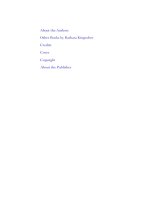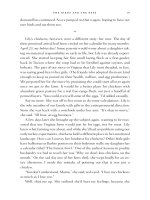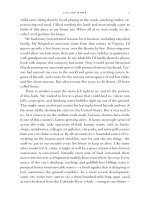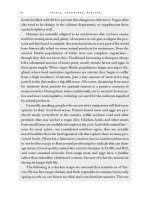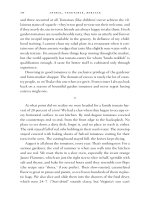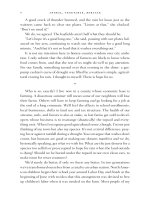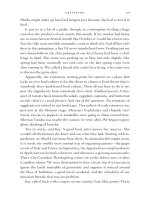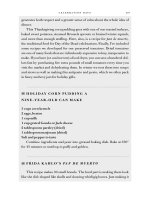Animal, vegetable, miracle a year of food life phần 3
Bạn đang xem bản rút gọn của tài liệu. Xem và tải ngay bản đầy đủ của tài liệu tại đây (63.68 KB, 5 trang )
called home
3
child came along shortly) loved playing in the creek, catching turtles, experiencing real mud. I liked working the land, and increasingly came to
think of this place as my home too. When all of us were ready, we decided, we’d go there for keeps.
We had many conventional reasons for relocation, including extended
family. My Kingsolver ancestors came from that county in Virginia; I’d
grown up only a few hours away, over the Kentucky line. Returning now
would allow my kids more than just a hit-and-run, holiday acquaintance
with grandparents and cousins. In my adult life I’d hardly shared a phone
book with anyone else using my last name. Now I could spend Memorial
Day decorating my ancestors’ graves with peonies from my backyard. Tucson had opened my eyes to the world and given me a writing career, legions of friends, and a taste for the sensory extravagance of red hot chiles
and five-alarm sunsets. But after twenty-five years in the desert, I’d been
called home.
There is another reason the move felt right to us, and it’s the purview
of this book. We wanted to live in a place that could feed us: where rain
falls, crops grow, and drinking water bubbles right up out of the ground.
This might seem an abstract reason for leaving beloved friends and one of
the most idyllic destination cities in the United States. But it was real to
us. As it closes in on the million-souls mark, Tucson’s charms have made
it one of this country’s fastest-growing cities. It keeps its people serviced
across the wide, wide spectrum of daily human wants, with its banks,
shops, symphonies, colleges, art galleries, city parks, and more golf courses
than you can shake a stick at. By all accounts it’s a bountiful source of everything on the human-need checklist, save for just the one thing—the
stuff we put in our mouths every few hours to keep us alive. Like many
other modern U.S. cities, it might as well be a space station where human
sustenance is concerned. Virtually every unit of food consumed there
moves into town in a refrigerated module from somewhere far away. Every
ounce of the city’s drinking, washing, and goldfish-bowl-filling water is
pumped from a nonrenewable source—a fossil aquifer that is dropping so
fast, sometimes the ground crumbles. In a more recent development,
some city water now arrives via a three-hundred-mile-long open canal
across the desert from the Colorado River, which—owing to our thirsts—
4
a n i m a l , v e g e ta b l e , m i r ac l e
is a river that no longer reaches the ocean, but peters out in a sand flat
near the Mexican border.
If it crosses your mind that water running through hundreds of miles
of open ditch in a desert will evaporate and end up full of concentrated
salts and muck, then let me just tell you, that kind of negative thinking
will never get you elected to public office in the state of Arizona. When
this giant new tap turned on, developers drew up plans to roll pink stucco
subdivisions across the desert in all directions. The rest of us were supposed to rejoice as the new flow rushed into our pipes, even as the city
warned us this water was kind of special. They said it was okay to drink,
but don’t put it in an aquarium because it would kill the fish.
Drink it we did, then, filled our coffee makers too, and mixed our children’s juice concentrate with fluid that would gag a guppy. Oh, America
the Beautiful, where are our standards? How did Europeans, ancestral
cultures to most of us, whose average crowded country would fit inside
one of our national parks, somehow hoard the market share of Beautiful?
They’ll run over a McDonald’s with a bulldozer because it threatens the
way of life of their fine cheeses. They have international trade hissy fits
when we try to slip modified genes into their bread. They get their favorite
ham from Parma, Italy, along with a favorite cheese, knowing these foods
are linked in an ancient connection the farmers have crafted between the
milk and the hogs. Oh. We were thinking Parmesan meant, not “coming
from Parma,” but “coming from a green shaker can.” Did they kick us out
for bad taste?
No, it was mostly for vagrancy, poverty, or being too religious. We came
here for the freedom to make a Leaves of Grass kind of culture and hear
America singing to a good beat, pierce our navels as needed, and eat whatever we want without some drudge scolding: “You don’t know where that’s
been!” And boy howdy, we do not.
The average food item on a U.S. grocery shelf has traveled farther than
most families go on their annual vacations. True fact. Fossil fuels were
consumed for the food’s transport, refrigeration, and processing, with the
obvious environmental consequences. The option of getting our household’s food from closer to home, in Tucson, seemed no better to us. The
Sonoran desert historically offered to humans baked dirt as a construc-
called home
5
tion material, and for eats, a corn-and-beans diet organized around late
summer monsoons, garnished in spring with cactus fruits and wild tubers. The Hohokam and Pima were the last people to live on that land
without creating an environmental overdraft. When the Spaniards arrived, they didn’t rush to take up the Hohokam diet craze. Instead they
set about working up a monumental debt: planting orange trees and alfalfa, digging wells for irrigation, withdrawing millions more gallons from
the water table each year than a dozen inches of annual rainfall could
ever restore. Arizona is still an agricultural state. Even after the popula-
Oily Food
Americans put almost as much fossil fuel into our refrigerators as our cars.
We’re consuming about 400 gallons of oil a year per citizen—about 17 percent
of our nation’s energy use—for agriculture, a close second to our vehicular use.
Tractors, combines, harvesters, irrigation, sprayers, tillers, balers, and other
equipment all use petroleum. Even bigger gas guzzlers on the farm are not the
machines, but so-called inputs. Synthetic fertilizers, pesticides, and herbicides
use oil and natural gas as their starting materials, and in their manufacturing.
More than a quarter of all farming energy goes into synthetic fertilizers.
But getting the crop from seed to harvest takes only one-fifth of the total oil
used for our food. The lion’s share is consumed during the trip from the farm to
your plate. Each food item in a typical U.S. meal has traveled an average of
1,500 miles. In addition to direct transport, other fuel-thirsty steps include processing (drying, milling, cutting, sorting, baking), packaging, warehousing, and
refrigeration. Energy calories consumed by production, packaging, and shipping
far outweigh the energy calories we receive from the food.
A quick way to improve food-related fuel economy would be to buy a quart
of motor oil and drink it. More palatable options are available. If every U.S. citizen
ate just one meal a week (any meal) composed of locally and organically raised
meats and produce, we would reduce our country’s oil consumption by over
1.1 million barrels of oil every week. That’s not gallons, but barrels. Small changes
in buying habits can make big differences. Becoming a less energy-dependent
nation may just need to start with a good breakfast.
STEVEN L. HOPP
6
a n i m a l , v e g e ta b l e , m i r ac l e
tion boom of the mid-nineties, 85 percent of the state’s water still went
to thirsty crops like cotton, alfalfa, citrus, and pecan trees. Mild winters
offer the opportunity to create an artificial endless summer, as long as
we can conjure up water and sustain a chemically induced illusion of topsoil.
Living in Arizona on borrowed water made me nervous. We belonged
to a far-flung little community of erstwhile Tucson homesteaders, raising
chickens in our yards and patches of vegetables for our own use, frequenting farmers’ markets to buy from Arizona farmers, trying to reduce the
miles-per-gallon quotient of our diets in a gasoholic world. But these gardens of ours had a drinking problem. So did Arizona farms. That’s a devil
of a choice: Rob Mexico’s water or guzzle Saudi Arabia’s gas?
Traditionally, employment and family dictate choices about where to
live. It’s also legitimate to consider weather, schools, and other quality-oflife indices. We added one more wish to our list: more than one out of
three of the basic elements necessary for human life. (Oxygen Arizona has
got.) If we’d had family ties, maybe we’d have felt more entitled to claim a
seat at Tucson’s lean dining table. But I moved there as a young adult,
then added through birth and marriage three more mouths to feed. As a
guest, I’d probably overstayed my welcome. So, as the U.S. population
made an unprecedented dash for the Sun Belt, one carload of us dogpaddled against the tide, heading for the Promised Land where water falls
from the sky and green stuff grows all around. We were about to begin the
adventure of realigning our lives with our food chain.
Naturally, our first stop was to buy junk food and fossil fuel.
In the cinder-block convenience mart we foraged the aisles for blue
corn chips and Craisins. Our family’s natural-foods teenager scooped up
a pile of energy bars big enough to pass as a retirement plan for a hamster.
Our family’s congenitally frugal Mom shelled out two bucks for a fancy
green bottle of about a nickel’s worth of iced tea. As long as we were all
going crazy here, we threw in some 99-cent bottles of what comes free
out of drinking fountains in places like Perrier, France. In our present location, 99 cents for good water seemed like a bargain. The goldfish should
be so lucky.
called home
7
As we gathered our loot onto the counter the sky darkened suddenly.
After two hundred consecutive cloudless days, you forget what it looks
like when a cloud crosses the sun. We all blinked. The cashier frowned
toward the plate-glass window.
“Dang,” she said, “it’s going to rain.”
“I hope so,” Steven said.
She turned her scowl from the window to Steven. This bleached-blond
guardian of gas pumps and snack food was not amused. “It better not, is
all I can say.”
“But we need it,” I pointed out. I am not one to argue with cashiers,
but the desert was dying, and this was my very last minute as a Tucsonan.
I hated to jinx it with bad precipitation-karma.
“I know that’s what they’re saying, but I don’t care. Tomorrow’s my first
day off in two weeks, and I want to wash my car.”
For three hundred miles we drove that day through desperately
parched Sonoran badlands, chewing our salty cashews with a peculiar
guilt. We had all shared this wish, in some way or another: that it wouldn’t
rain on our day off. Thunderheads dissolved ahead of us, as if honoring
our compatriot’s desire to wash her car as the final benediction pronounced on a dying land. In our desert, we would not see rain again.
/
It took us five days to reach the farm. On our first full day there we
spent ten hours mowing, clearing brush, and working on the farmhouse.
Too tired to cook, we headed into town for supper, opting for a diner of
the southern type that puts grits on your plate until noon and biscuits after, whether you ask for them or not. Our waitress was young and chatty, a
student at the junior college nearby studying to be a nurse or else, if she
doesn’t pass the chemistry, a television broadcaster. She said she was
looking forward to the weekend, but smiled broadly nevertheless at the
clouds gathering over the hills outside. The wooded mountainsides and
velvet pastures of southwestern Virginia looked remarkably green to our
desert-scorched eyes, but the forests and fields were suffering here too.
Drought had plagued most of the southern United States that spring.

